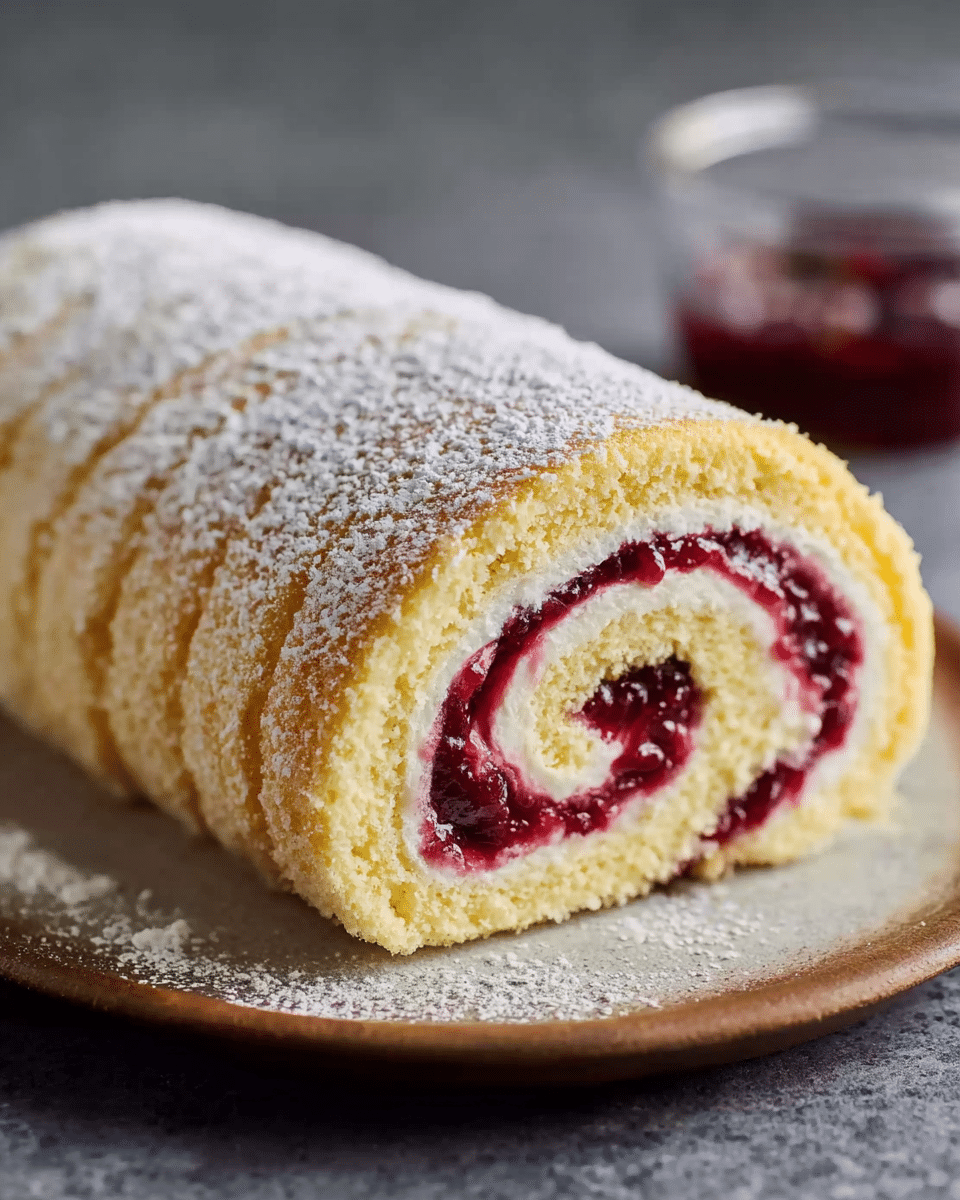Mary Berry’s Swiss Roll is a timeless dessert that features a light, airy sponge wrapped around a sweet raspberry jam filling. This classic British bake is simple yet impressive, making it a perfect choice for special occasions or a delightful afternoon tea. The key is in the sponge’s texture—light and pliable enough to roll without cracking—and the balanced sweetness of the jam.
Full Recipe:
Ingredients
For the Sponge:
-
1 tsp butter (for greasing)
-
4 large eggs (room temperature)
-
½ cup granulated sugar (plus extra for sprinkling)
-
1 cup self-raising flour
-
1 tbsp confectioners’ sugar (for final dusting)
For the Filling:
-
¼ cup raspberry jam (or jam of your choice)
Directions
-
Prepare the Pan:
Preheat oven to 425°F (220°C). Grease a 9×13 inch (23×33 cm) Swiss roll pan, line it with parchment paper, and lightly grease the paper. -
Make the Batter:
Beat eggs and sugar with an electric mixer on high speed until the mixture is pale and thick enough to leave a ribbon trail.
Sift in the flour and gently fold it into the egg mixture until combined. -
Bake the Sponge:
Pour the batter into the prepared pan and gently spread it to the edges.
Bake for about 10 minutes until golden and starting to pull from the sides. -
Roll the Cake:
Turn the baked sponge out onto a piece of parchment sprinkled with sugar.
Peel off the lining paper and trim the edges.
Starting from a short side, roll the sponge with the sugared parchment and let it sit for 2–3 minutes. -
Add the Filling:
Carefully unroll the sponge, discard parchment, and spread warmed raspberry jam evenly over the surface.
Roll it up again tightly. -
Finish and Serve:
Wrap the roll in parchment to cool. Before serving, dust with confectioners’ sugar and slice into rounds.
Nutrients (Per slice — Approximate based on 10 slices)
-
Calories: ~170 kcal
-
Carbohydrates: 27g
-
Protein: 4g
-
Fat: 4g
-
Sugar: ~18g
-
Fiber: <1g
Origins of the Swiss Roll
Despite the name, the Swiss Roll is not from Switzerland. Historians trace its origins back to Central Europe in the 19th century, though the exact country of invention is still debated. In Britain, it quickly became a beloved staple in home baking thanks to its decorative look and uncomplicated nature. The jam roll was embraced for its minimal ingredients and short baking time, making it a popular dessert long before the era of modern kitchen appliances.
Mary Berry, known for her no-fuss, reliably delicious recipes, has helped reintroduce the Swiss Roll to modern audiences. Her version sticks to tradition while emphasizing the quality of the sponge, using only the essentials to achieve that perfect light texture. It’s a clear example of how timeless techniques, when executed well, continue to impress even in today’s more experimental culinary climate.
The Art of the Sponge
The heart of a Swiss Roll is its sponge, and Mary Berry’s recipe exemplifies how to master it. The key lies in creating a batter that’s light and airy enough to hold its structure, yet flexible enough to roll while still warm. Beating the eggs and sugar until they are thick and pale is crucial—this step builds the volume that gives the sponge its signature lift without the need for chemical leaveners.
Folding in the flour gently maintains this aeration, ensuring the sponge doesn’t collapse or become dense. Once baked, the sponge is soft, golden, and slightly springy to the touch—perfect for rolling while warm, so it maintains shape without breaking. This process requires a bit of timing and finesse, but Mary Berry’s recipe is designed with home bakers in mind, demystifying a dessert that looks more complex than it actually is.
The Sweet Simplicity of Raspberry Jam
While many modern variations of Swiss Roll include whipped cream, ganache, or even fresh fruit, Mary Berry stays true to the classic with a simple raspberry jam filling. The tartness of the raspberry balances the sweetness of the sponge, creating a satisfying contrast that doesn’t overwhelm the palate. Using good-quality jam, preferably warmed to spread easily, ensures even distribution and enhances the overall flavor.
This minimalistic approach allows the texture of the sponge and the brightness of the jam to shine. The result is a cake that feels light yet indulgent—a perfect treat for those who appreciate understated elegance in their desserts.
Presentation and Occasion
One of the most appealing aspects of the Swiss Roll is its visual charm. The spiral of sponge and jam is instantly recognizable and adds a decorative element to any dessert table. A dusting of confectioners’ sugar provides a classic finish, and a clean slice reveals the beautiful swirl within, making it both a showstopper and a comfort bake.
Because of its refined look and light taste, the Swiss Roll is ideal for a variety of occasions. It works beautifully for afternoon tea, holiday gatherings, or as a quick dessert to impress unexpected guests. It’s also an excellent choice for baking competitions and school projects, thanks to its combination of technical skill and aesthetic appeal.
A Dessert That Encourages Skill and Creativity
Although Mary Berry’s version keeps things simple, the Swiss Roll can serve as a canvas for creativity. Once you’ve mastered the basic sponge and jam roll, you can begin to experiment with other fillings—such as lemon curd, chocolate spread, or mascarpone and berries. Some adventurous bakers even infuse the sponge with citrus zest or flavor extracts for added complexity.
Still, Mary’s take is a wonderful reminder that sometimes, less is more. Her restrained, thoughtful approach helps new bakers build confidence in core techniques like folding, rolling, and sponge baking—all essential skills in the broader world of patisserie.
Why It’s a Mary Berry Favorite
Mary Berry is revered for her ability to bring timeless British recipes to the modern kitchen, making them approachable for bakers of all levels. Her Swiss Roll is no exception. She eliminates unnecessary steps, offers precise timing, and uses familiar ingredients, making her recipe foolproof for anyone willing to follow her method.
Her emphasis on achieving the perfect sponge—light, flexible, and flavorful—demonstrates her deep understanding of texture and balance. It’s not just about replicating a recipe, but about baking something that feels classic and personal at the same time. Mary’s version is accessible yet elegant, which is the hallmark of all her bakes.
Swiss Roll in the Modern Kitchen
With the resurgence of interest in traditional bakes, especially during the home-baking boom of recent years, the Swiss Roll has found renewed popularity. Its short ingredient list and quick baking time make it ideal for today’s busy schedules, while its nostalgic flavor and lovely presentation appeal to those who cherish classic recipes.
Whether you’re a seasoned baker or a novice just starting out, the Swiss Roll is a perfect introduction to sponge-based desserts. Mary Berry’s clear, encouraging method turns what might seem like a daunting bake into an achievable—and highly rewarding—project.
Conclusion: The Swiss Roll, A Timeless Triumph
Mary Berry’s Swiss Roll is more than just a dessert—it’s a testament to the beauty of simplicity in baking. With just a handful of ingredients and a bit of care, you can create a visually stunning, deliciously light cake that has delighted generations. Its elegance lies not in complexity, but in precision and tradition.
This recipe embodies everything Mary Berry represents: dependable technique, accessible ingredients, and a touch of British charm. Whether enjoyed with a steaming cup of Earl Grey or presented at a festive gathering, the Swiss Roll brings warmth, nostalgia, and satisfaction in every swirl. A true classic, reimagined and refined for the modern baker, yet always rooted in the heart of home baking.






